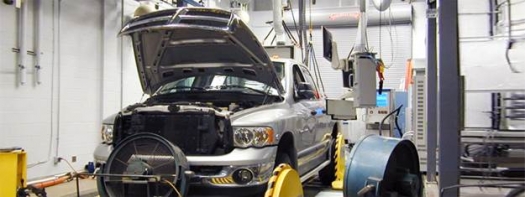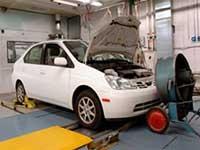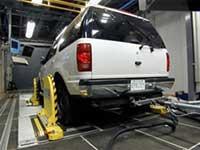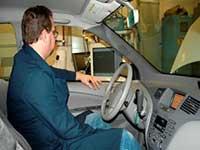Testing at the National Vehicle and Fuel Emissions Laboratory

EPA's National Vehicle and Fuel Emissions Laboratory (NVFEL) tests new cars and trucks sold in the U.S. to ensure that they comply with federal emissions and fuel economy standards.
Certification Emission Testing
All new cars and trucks sold in the U.S. must be certified to meet federal emission standards, such as limits on the amount of smog-forming and greenhouse gas emissions that they can produce. Most testing is performed by auto manufacturers at their own facilities. EPA then audits the data and performs its own testing on some of the vehicles to confirm the manufacturers' results.
Fuel Economy Testing
EPA is also responsible for providing fuel economy data for the fuel economy label (or window sticker) that you see on all new cars and light trucks, and for the Corporate Average Fuel Economy (CAFE) program.
The data is also used by:
- The U.S. Department of Energy (DOE) to publish the annual Fuel Economy Guide
- The U.S. Department of Transportation (DOT) to administer the Corporate Average Fuel Economy (CAFE) program
- The Internal Revenue Service (IRS) to collect "Gas Guzzler" taxes
As with emissions testing, data is derived from vehicle testing done at NVFEL and by vehicle manufacturers who submit their own test data to EPA for verification. More information about how vehicles are tested and test procedure schedules.
 The vehicle is tested in a dynamometer test cell, which works like a treadmill for cars.
The vehicle is tested in a dynamometer test cell, which works like a treadmill for cars.  A hose is connected to the tailpipe to collect engine exhaust. Carbon is measured to calculate the amount of fuel burned. Other air pollutants are measured using gas analyzers, and fine particles (particulate matter, PM) are weighed in a special "clean room."*
A hose is connected to the tailpipe to collect engine exhaust. Carbon is measured to calculate the amount of fuel burned. Other air pollutants are measured using gas analyzers, and fine particles (particulate matter, PM) are weighed in a special "clean room."*
* Some of these methods will differ for alternative-fueled vehicles, such as electric vehicles. A driver operates the vehicle following driving "schedules," which simulate typical trips (including specific speeds and acceleration, different temperatures, use of A/C, etc)
A driver operates the vehicle following driving "schedules," which simulate typical trips (including specific speeds and acceleration, different temperatures, use of A/C, etc)
